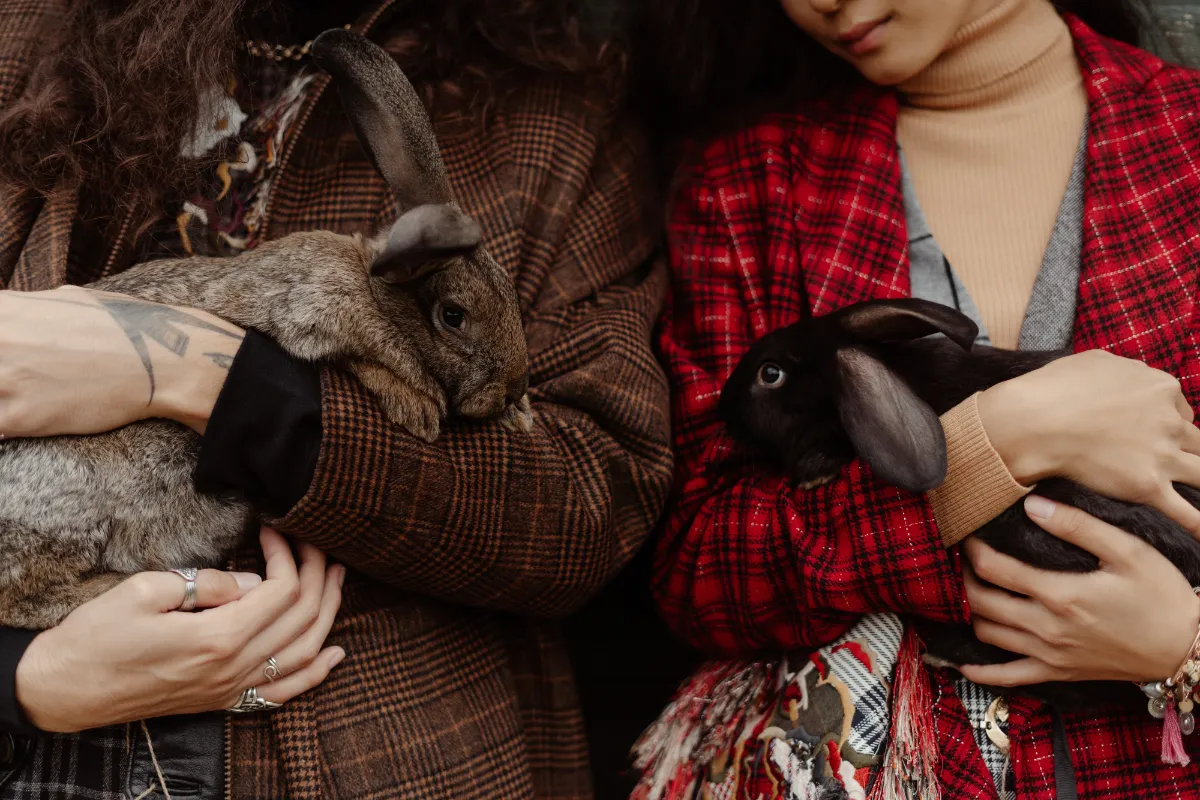Are you ready to learn the proper way to hold a rabbit?
Before you begin, remember to prioritize safety at all times. By understanding a rabbit’s body language and using the correct technique, you can ensure a calm and comfortable experience for both you and the rabbit.
In this article, we will guide you through the steps of picking up and holding a rabbit, as well as provide tips for soothing a nervous rabbit and safely putting them back down.
Let’s get started!
In This Article
- 1 Key Takeaways
- 2 Safety Precautions for Holding a Rabbit
- 3 Understanding a Rabbit’s Body Language
- 4 The Proper Technique for Picking Up a Rabbit
- 5 Supporting a Rabbit’s Body During Holding
- 6 Tips for Calming a Nervous Rabbit
- 7 How to Safely Put Down a Rabbit After Holding
- 8 Frequently Asked Questions
- 9 Conclusion
Key Takeaways
- Handle rabbits properly by placing one hand under their chest and supporting their hind legs
- Interpret a rabbit’s body language by observing their ear movements and recognizing signs of aggression
- Use the proper technique for picking up a rabbit by scooping them under their chest and supporting their hindquarters
- Support a rabbit’s body during holding by setting up a safe space, avoiding sudden movements or loud noises, and providing a comfortable environment
Safety Precautions for Holding a Rabbit
Do you know what safety precautions to take when holding a rabbit?
It’s important to handle rabbits properly to ensure their safety and well-being. Many people make common rabbit handling mistakes, such as not supporting the rabbit’s hind legs or squeezing them too tightly. To avoid these mistakes, always approach the rabbit calmly and gently. Place one hand under their chest and the other hand supporting their hind legs. This way, you provide proper support and prevent any potential injuries.
Additionally, bonding with your rabbit is crucial for their socialization and trust. Spend time with them every day, petting and talking to them softly. This will help strengthen your bond and create a positive and loving relationship.
Understanding a Rabbit’s Body Language
If you observe closely, you can understand a rabbit’s body language to better communicate and interact with them. Rabbits use various forms of communication, and being able to interpret their body language is essential in understanding their needs and emotions. Here are some key aspects to consider:
- Interpreting a rabbit’s ear movements:
- Upright and forward ears indicate curiosity and attentiveness.
- Ears laid flat against the back of the head may signal fear or submission.
- Rapid and constant ear flicking can indicate discomfort or irritation.
- Recognizing signs of aggression in a rabbit’s body language:
- Growling or grunting sounds accompanied by tense body posture indicate aggression.
- Charging or lunging towards an object or person can be a sign of territorial behavior.
- Biting or scratching is a clear indication of aggression and should be taken seriously.
Understanding a rabbit’s body language allows you to respond appropriately and provide the necessary care and attention. By being attentive to their nonverbal cues, you can create a harmonious and enriching environment for your furry friend.
The Proper Technique for Picking Up a Rabbit

To properly pick up a rabbit, gently scoop them under their chest and support their hindquarters. This technique ensures that you maintain control and minimize the risk of injury to the rabbit.
When handling a rabbit, it’s important to avoid common mistakes that can cause them stress or harm. One common mistake is grabbing them by the ears or scruff, which can be painful and frightening for the rabbit. Another mistake is picking them up by their legs, which can lead to fractures or dislocations.
Instead, focus on bonding with your rabbit through gentle handling. Use a calm and soothing voice, and approach them slowly to avoid startling them. By showing them patience and respect, you can build a strong bond and create a positive experience for both of you.
Supporting a Rabbit’s Body During Holding
Remember to always support a rabbit’s body both under their chest and their hindquarters when holding them, as this helps to ensure their comfort and safety. Rabbits are delicate creatures, and improper handling can cause them stress or even injury.
To provide a comfortable environment for your rabbit, follow these guidelines:
- Creating a Safe Space: Set up a designated area where your rabbit can roam freely and feel secure. This can be achieved with a playpen or a rabbit-proofed room.
- Avoiding Sudden Movements: Rabbits are easily frightened by sudden movements or loud noises. Approach them slowly and calmly to avoid startling them.
- Proper Holding Technique: When picking up a rabbit, support their body by placing one hand under their chest and the other hand under their hindquarters. This helps distribute their weight evenly and prevents them from feeling insecure or unsupported.
Tips for Calming a Nervous Rabbit
Take a few deep breaths and gently stroke your rabbit’s fur with your hand to help calm them down. Bonding with a nervous rabbit can be challenging, but with the right techniques and a calming environment, you can create a strong connection. Here are some tips to help you bond with your nervous rabbit:
| Techniques for bonding with a nervous rabbit | Creating a calming environment for a nervous rabbit |
|---|---|
| – Spend quality time with your rabbit, sitting near their enclosure and talking softly to them. | – Provide a quiet and peaceful space for your rabbit, away from loud noises and sudden movements. |
| – Offer treats and rewards to associate positive experiences with your presence. | – Use soft lighting and soothing music to create a relaxed atmosphere. |
| – Approach your rabbit slowly and gently, avoiding sudden movements. | – Use a soft blanket or towel to create a cozy hiding spot for your rabbit. |
How to Safely Put Down a Rabbit After Holding
When you finish holding your rabbit, gently place them back in their enclosure. This is an important step to ensure the safety and well-being of your pet.
When putting down a rabbit, it’s crucial to handle them with care to prevent any injuries. Here are some guidelines to follow:
- Slowly lower the rabbit towards the ground, supporting their hindquarters with one hand and their front paws with the other.
- Keep a firm but gentle grip to provide stability and prevent any sudden movements.
- Make sure to place the rabbit on a soft surface, such as a blanket or towel, to cushion their landing.
By following these steps, you can ensure that your rabbit is safely returned to their enclosure without any harm.
Frequently Asked Questions
How Do I Know if My Rabbit Is Comfortable Being Held?
To determine if your rabbit is comfortable being held, look for signs of a relaxed rabbit such as calm body language, floppy ears, and a steady heartbeat. Building trust with your rabbit through gentle handling and positive reinforcement will also help.
Can I Hold My Rabbit if It Has Just Eaten?
You can hold your rabbit after it has eaten, but be cautious. If your rabbit doesn’t like to be held, try practicing proper handling techniques slowly and gently to build trust over time.
Is It Safe to Hold a Rabbit by Its Ears or Tail?
Holding a rabbit by its ears or tail can be dangerous and cause serious harm. It’s important to learn proper techniques for holding a rabbit safely to avoid the risks associated with improper handling.
What Should I Do if My Rabbit Starts Scratching or Biting While I’m Holding It?
If your rabbit starts scratching or biting while you’re holding it, it can be a sign of stress or fear. To handle this aggressive behavior, gently release your grip and give your rabbit some space to calm down.
Can I Let My Children Hold Our Pet Rabbit?
Children should not hold rabbits alone due to the risks involved. Instead, supervised interaction is recommended. Alternatives include petting, grooming, or playing with the rabbit in a controlled environment to ensure the safety of both the child and the pet.
Conclusion
In conclusion, by following the proper techniques and understanding a rabbit’s body language, you can safely and confidently hold and handle your pet rabbit.
Remember the adage, ‘Handle with care,’ as it emphasizes the importance of being gentle and cautious when interacting with these delicate creatures.
By providing a secure and supportive hold, you can create a calm and comfortable environment for your rabbit, ensuring a positive and enjoyable experience for both of you.





